Comparative Financial Analysis of Sainsbury's and Tesco's Performance
VerifiedAdded on 2021/02/19
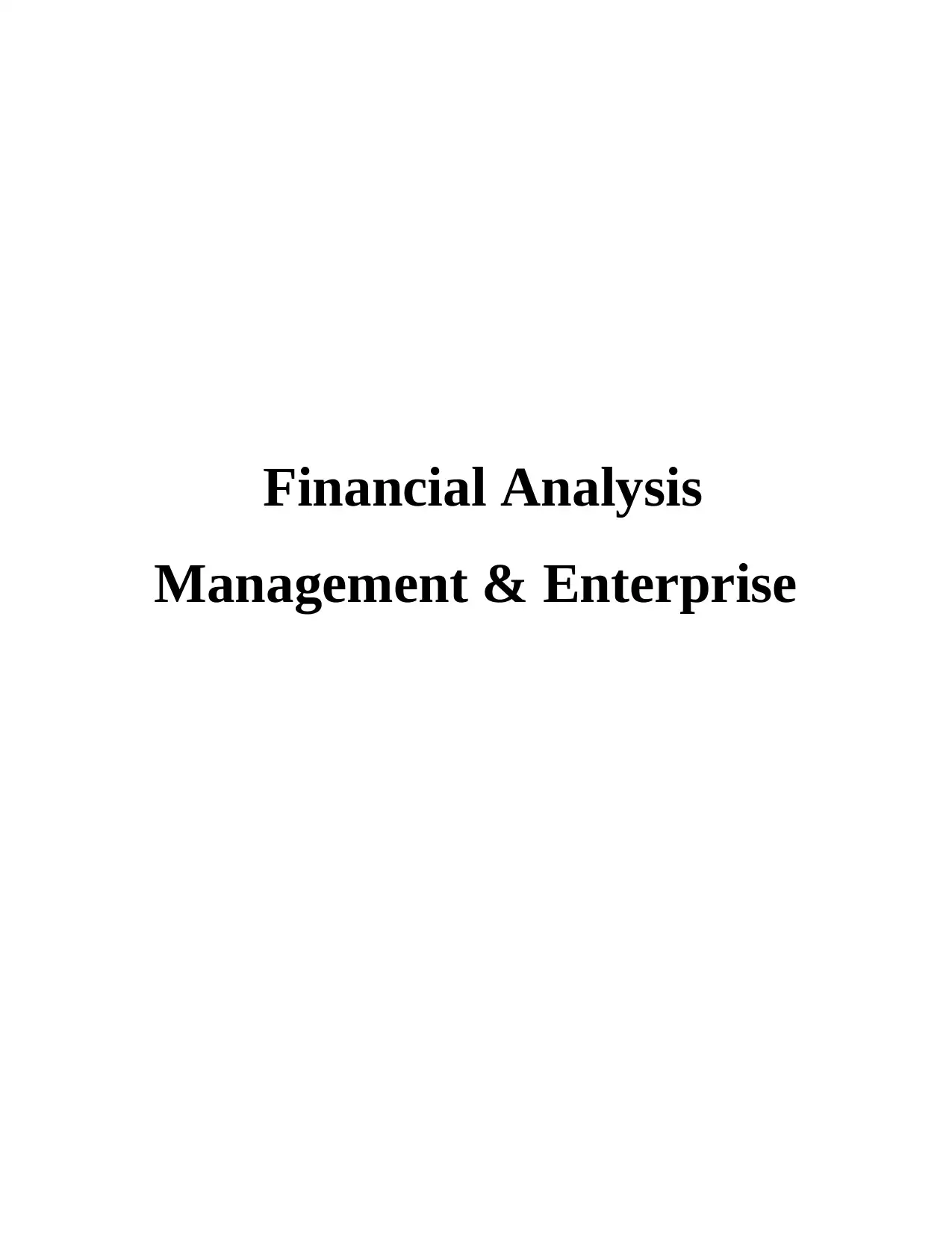
Management & Enterprise
Paraphrase This Document
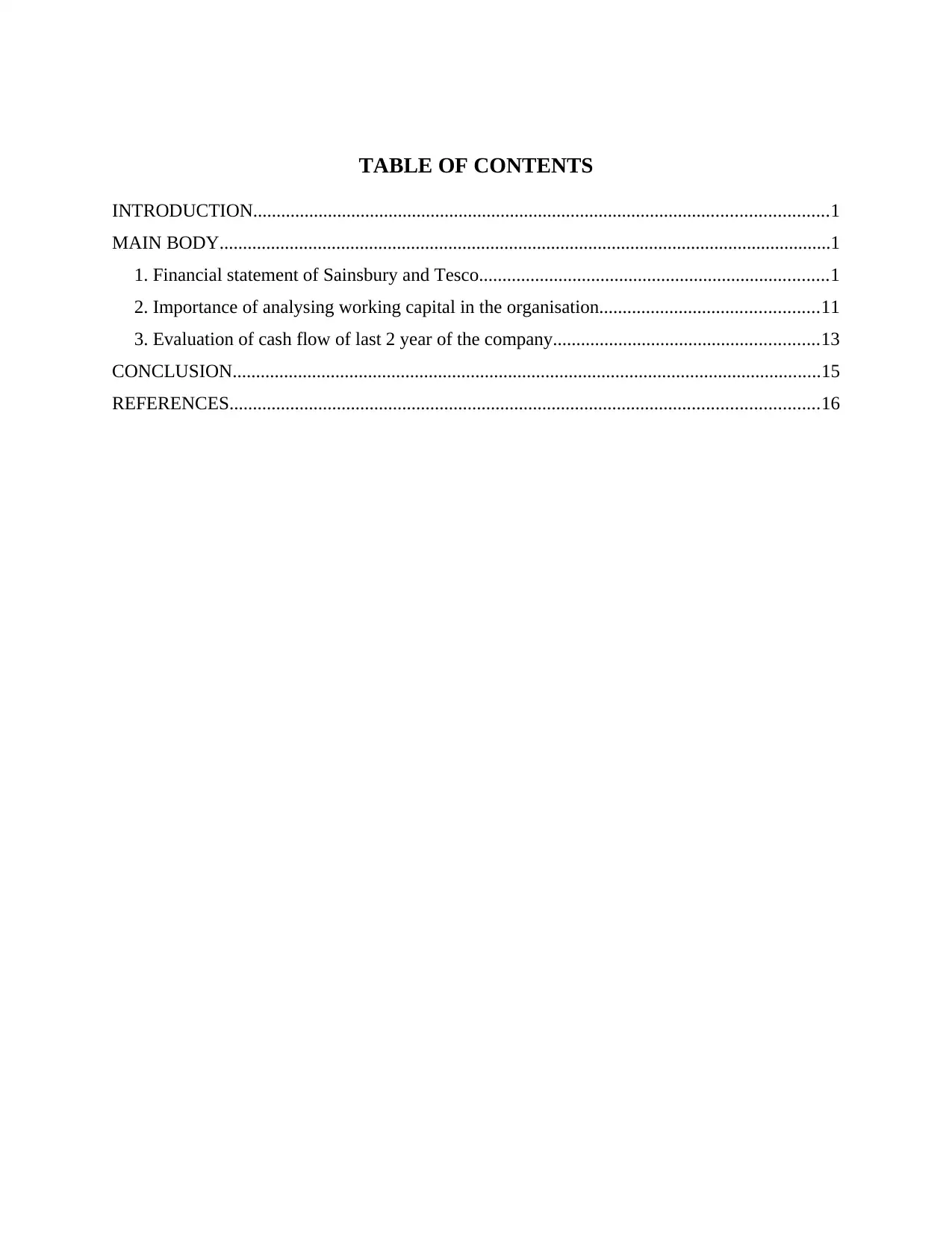
INTRODUCTION...........................................................................................................................1
MAIN BODY...................................................................................................................................1
1. Financial statement of Sainsbury and Tesco...........................................................................1
2. Importance of analysing working capital in the organisation...............................................11
3. Evaluation of cash flow of last 2 year of the company.........................................................13
CONCLUSION..............................................................................................................................15
REFERENCES..............................................................................................................................16
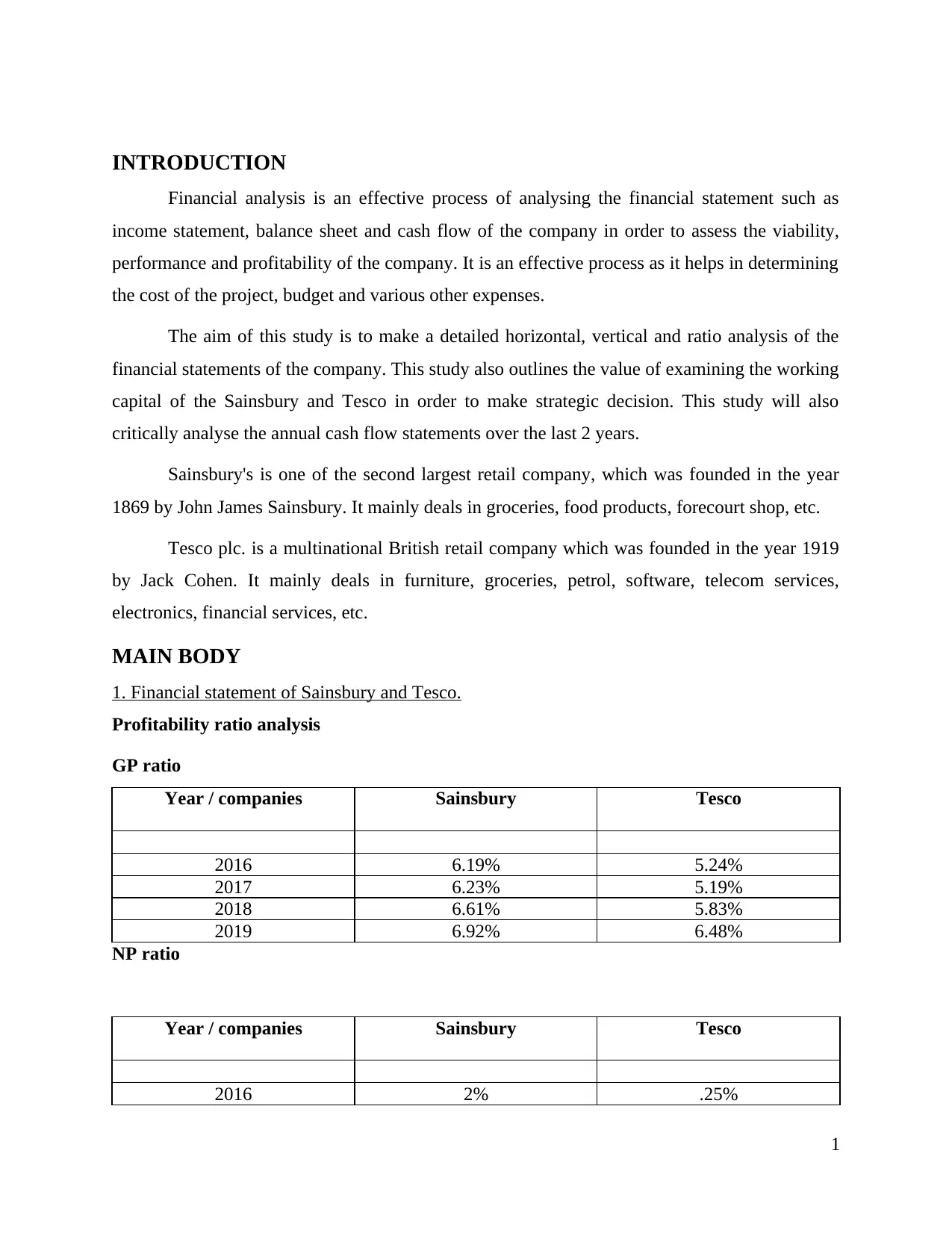
Financial analysis is an effective process of analysing the financial statement such as
income statement, balance sheet and cash flow of the company in order to assess the viability,
performance and profitability of the company. It is an effective process as it helps in determining
the cost of the project, budget and various other expenses.
The aim of this study is to make a detailed horizontal, vertical and ratio analysis of the
financial statements of the company. This study also outlines the value of examining the working
capital of the Sainsbury and Tesco in order to make strategic decision. This study will also
critically analyse the annual cash flow statements over the last 2 years.
Sainsbury's is one of the second largest retail company, which was founded in the year
1869 by John James Sainsbury. It mainly deals in groceries, food products, forecourt shop, etc.
Tesco plc. is a multinational British retail company which was founded in the year 1919
by Jack Cohen. It mainly deals in furniture, groceries, petrol, software, telecom services,
electronics, financial services, etc.
MAIN BODY
1. Financial statement of Sainsbury and Tesco.
Profitability ratio analysis
GP ratio
Year / companies Sainsbury Tesco
2016 6.19% 5.24%
2017 6.23% 5.19%
2018 6.61% 5.83%
2019 6.92% 6.48%
NP ratio
Year / companies Sainsbury Tesco
2016 2% .25%
1
⊘ This is a preview!⊘
Do you want full access?
Subscribe today to unlock all pages.

Trusted by 1+ million students worldwide
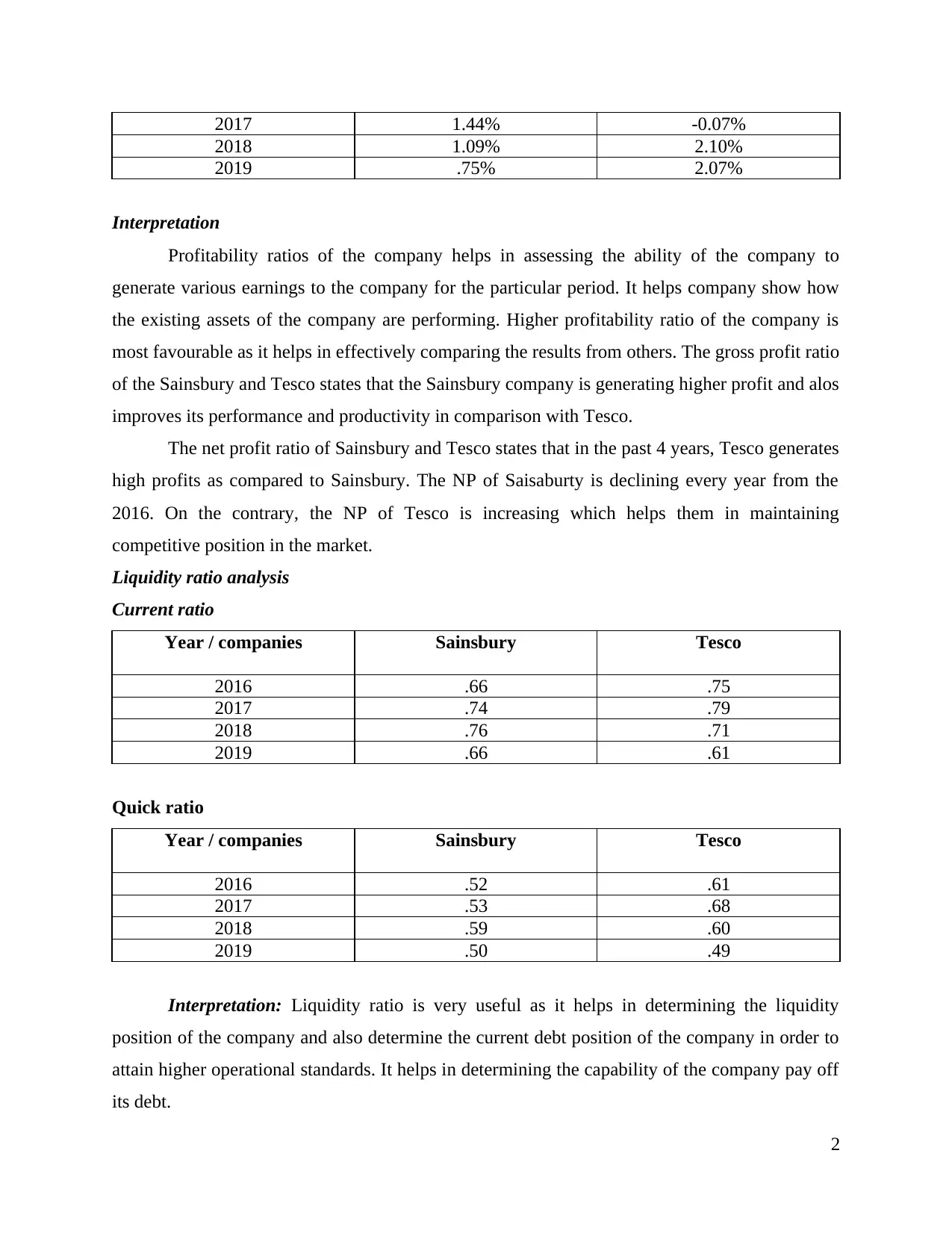
2018 1.09% 2.10%
2019 .75% 2.07%
Interpretation
Profitability ratios of the company helps in assessing the ability of the company to
generate various earnings to the company for the particular period. It helps company show how
the existing assets of the company are performing. Higher profitability ratio of the company is
most favourable as it helps in effectively comparing the results from others. The gross profit ratio
of the Sainsbury and Tesco states that the Sainsbury company is generating higher profit and alos
improves its performance and productivity in comparison with Tesco.
The net profit ratio of Sainsbury and Tesco states that in the past 4 years, Tesco generates
high profits as compared to Sainsbury. The NP of Saisaburty is declining every year from the
2016. On the contrary, the NP of Tesco is increasing which helps them in maintaining
competitive position in the market.
Liquidity ratio analysis
Current ratio
Year / companies Sainsbury Tesco
2016 .66 .75
2017 .74 .79
2018 .76 .71
2019 .66 .61
Quick ratio
Year / companies Sainsbury Tesco
2016 .52 .61
2017 .53 .68
2018 .59 .60
2019 .50 .49
Interpretation: Liquidity ratio is very useful as it helps in determining the liquidity
position of the company and also determine the current debt position of the company in order to
attain higher operational standards. It helps in determining the capability of the company pay off
its debt.
2
Paraphrase This Document
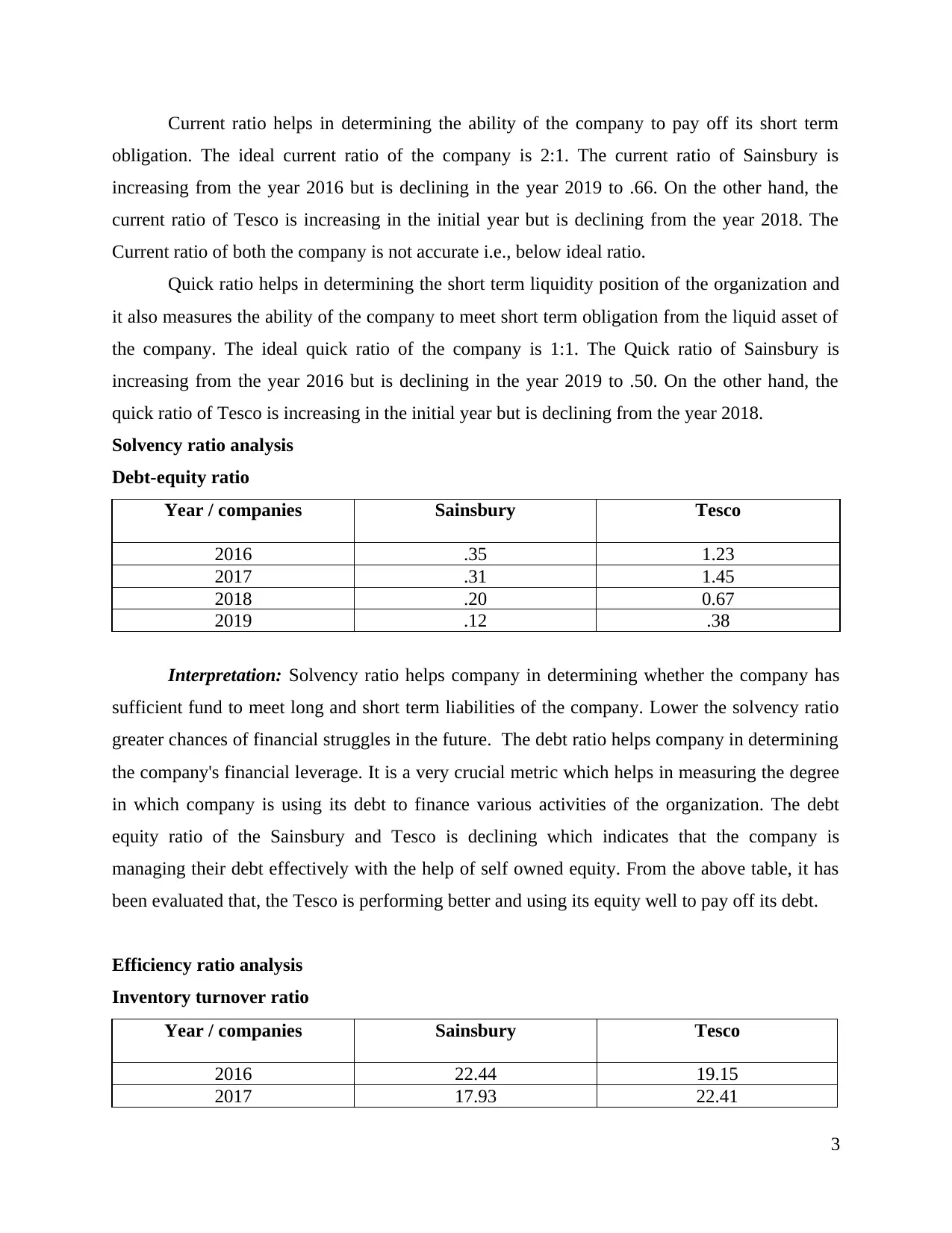
obligation. The ideal current ratio of the company is 2:1. The current ratio of Sainsbury is
increasing from the year 2016 but is declining in the year 2019 to .66. On the other hand, the
current ratio of Tesco is increasing in the initial year but is declining from the year 2018. The
Current ratio of both the company is not accurate i.e., below ideal ratio.
Quick ratio helps in determining the short term liquidity position of the organization and
it also measures the ability of the company to meet short term obligation from the liquid asset of
the company. The ideal quick ratio of the company is 1:1. The Quick ratio of Sainsbury is
increasing from the year 2016 but is declining in the year 2019 to .50. On the other hand, the
quick ratio of Tesco is increasing in the initial year but is declining from the year 2018.
Solvency ratio analysis
Debt-equity ratio
Year / companies Sainsbury Tesco
2016 .35 1.23
2017 .31 1.45
2018 .20 0.67
2019 .12 .38
Interpretation: Solvency ratio helps company in determining whether the company has
sufficient fund to meet long and short term liabilities of the company. Lower the solvency ratio
greater chances of financial struggles in the future. The debt ratio helps company in determining
the company's financial leverage. It is a very crucial metric which helps in measuring the degree
in which company is using its debt to finance various activities of the organization. The debt
equity ratio of the Sainsbury and Tesco is declining which indicates that the company is
managing their debt effectively with the help of self owned equity. From the above table, it has
been evaluated that, the Tesco is performing better and using its equity well to pay off its debt.
Efficiency ratio analysis
Inventory turnover ratio
Year / companies Sainsbury Tesco
2016 22.44 19.15
2017 17.93 22.41
3

2019 14.44 24.49
Total assets turnover ratio
Year / companies Sainsbury Tesco
2016 1.40 1.24
2017 1.43 1.25
2018 1.36 1.27
2019 1.27 1.36
Fixed assets turnover ratio
Year / companies Sainsbury Tesco
2016 1.91 1.78
2017 2.02 1.88
2018 2.07 1.87
2019 1.93 1.89
Interpretation: Efficiency ratio helps in analysing how well the company is using its
assets and liabilities. It helps in evaluating the performance and financial position of the
company. The Inventory turnover ratio of the company helps in evaluating how must time is
taken to sell and replace the inventory during the particular period. A high inventory ratio
indicates that the company is performing well and is effectively managing all the stock. From the
above study it has been evaluated, that the Tesco company is effectively managing its inventory
and leads to higher sales and profit. The Total assets turnover ratio that helps in measuring the
ability of the company to generate sales by effectively using the asset of the organization. A high
total asset turnover ratio indicates the company is performing better. Sainsbury company
effectively use its assets to generate higher sales.
Investment ratios
Earnings per share
Year / companies Sainsbury Tesco
2016 .23 0.05
2017 .17 (0.01)
2018 .13 .44
4
⊘ This is a preview!⊘
Do you want full access?
Subscribe today to unlock all pages.

Trusted by 1+ million students worldwide
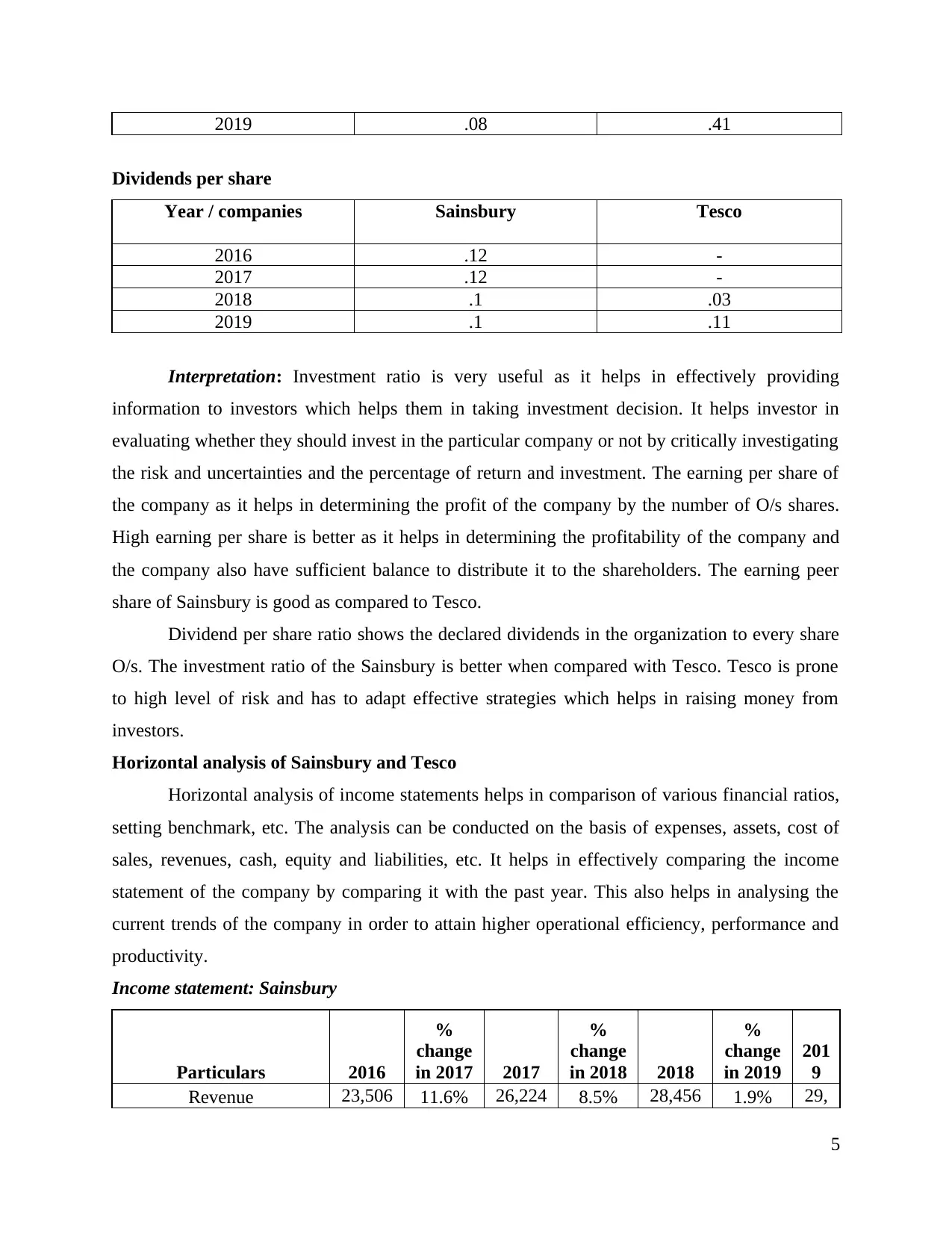
Dividends per share
Year / companies Sainsbury Tesco
2016 .12 -
2017 .12 -
2018 .1 .03
2019 .1 .11
Interpretation: Investment ratio is very useful as it helps in effectively providing
information to investors which helps them in taking investment decision. It helps investor in
evaluating whether they should invest in the particular company or not by critically investigating
the risk and uncertainties and the percentage of return and investment. The earning per share of
the company as it helps in determining the profit of the company by the number of O/s shares.
High earning per share is better as it helps in determining the profitability of the company and
the company also have sufficient balance to distribute it to the shareholders. The earning peer
share of Sainsbury is good as compared to Tesco.
Dividend per share ratio shows the declared dividends in the organization to every share
O/s. The investment ratio of the Sainsbury is better when compared with Tesco. Tesco is prone
to high level of risk and has to adapt effective strategies which helps in raising money from
investors.
Horizontal analysis of Sainsbury and Tesco
Horizontal analysis of income statements helps in comparison of various financial ratios,
setting benchmark, etc. The analysis can be conducted on the basis of expenses, assets, cost of
sales, revenues, cash, equity and liabilities, etc. It helps in effectively comparing the income
statement of the company by comparing it with the past year. This also helps in analysing the
current trends of the company in order to attain higher operational efficiency, performance and
productivity.
Income statement: Sainsbury
Particulars 2016
%
change
in 2017 2017
%
change
in 2018 2018
%
change
in 2019
201
9
Revenue 23,506 11.6% 26,224 8.5% 28,456 1.9% 29,
5
Paraphrase This Document
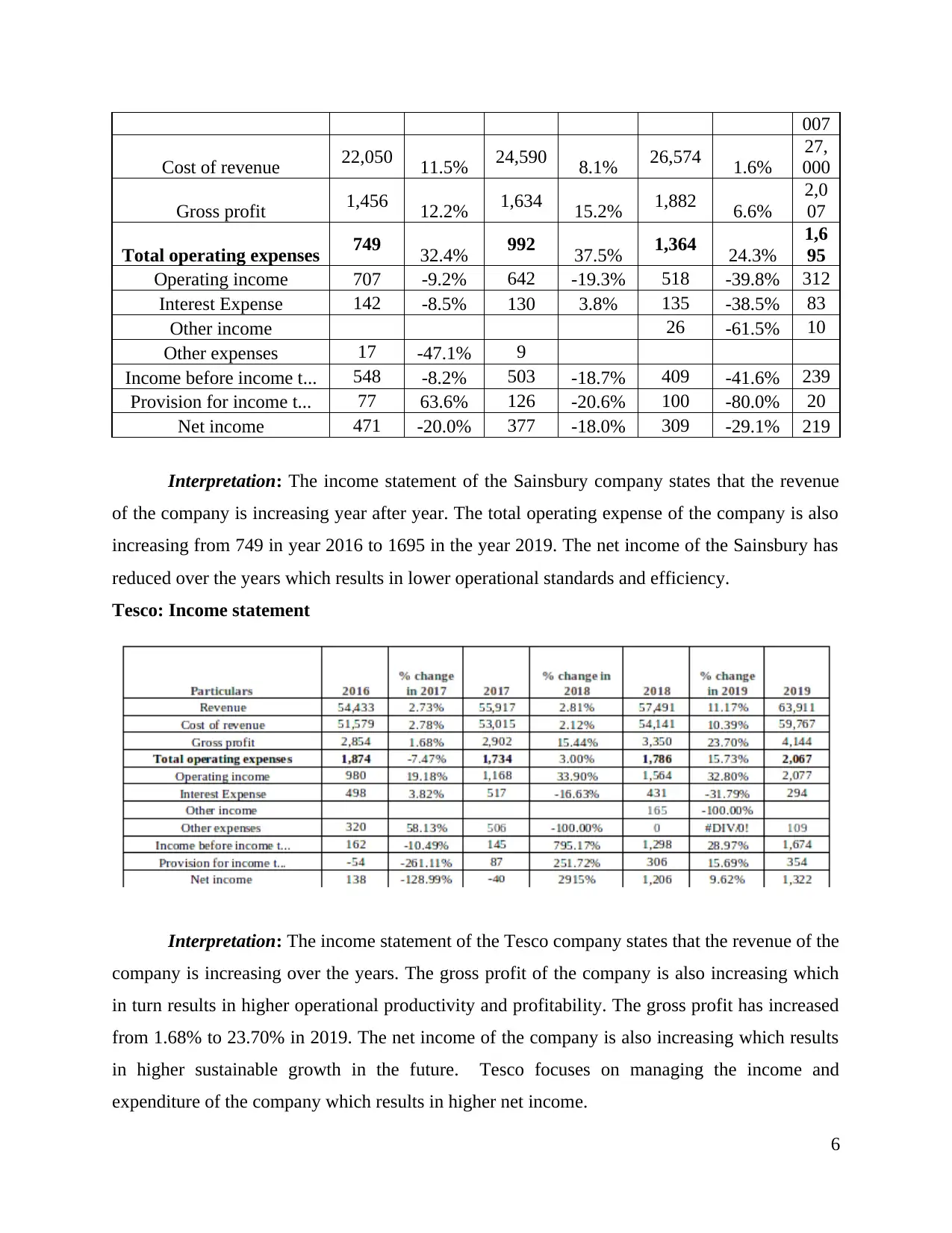
Cost of revenue 22,050 11.5% 24,590 8.1% 26,574 1.6%
27,
000
Gross profit 1,456 12.2% 1,634 15.2% 1,882 6.6%
2,0
07
Total operating expenses 749 32.4% 992 37.5% 1,364 24.3%
1,6
95
Operating income 707 -9.2% 642 -19.3% 518 -39.8% 312
Interest Expense 142 -8.5% 130 3.8% 135 -38.5% 83
Other income 26 -61.5% 10
Other expenses 17 -47.1% 9
Income before income t... 548 -8.2% 503 -18.7% 409 -41.6% 239
Provision for income t... 77 63.6% 126 -20.6% 100 -80.0% 20
Net income 471 -20.0% 377 -18.0% 309 -29.1% 219
Interpretation: The income statement of the Sainsbury company states that the revenue
of the company is increasing year after year. The total operating expense of the company is also
increasing from 749 in year 2016 to 1695 in the year 2019. The net income of the Sainsbury has
reduced over the years which results in lower operational standards and efficiency.
Tesco: Income statement
Interpretation: The income statement of the Tesco company states that the revenue of the
company is increasing over the years. The gross profit of the company is also increasing which
in turn results in higher operational productivity and profitability. The gross profit has increased
from 1.68% to 23.70% in 2019. The net income of the company is also increasing which results
in higher sustainable growth in the future. Tesco focuses on managing the income and
expenditure of the company which results in higher net income.
6
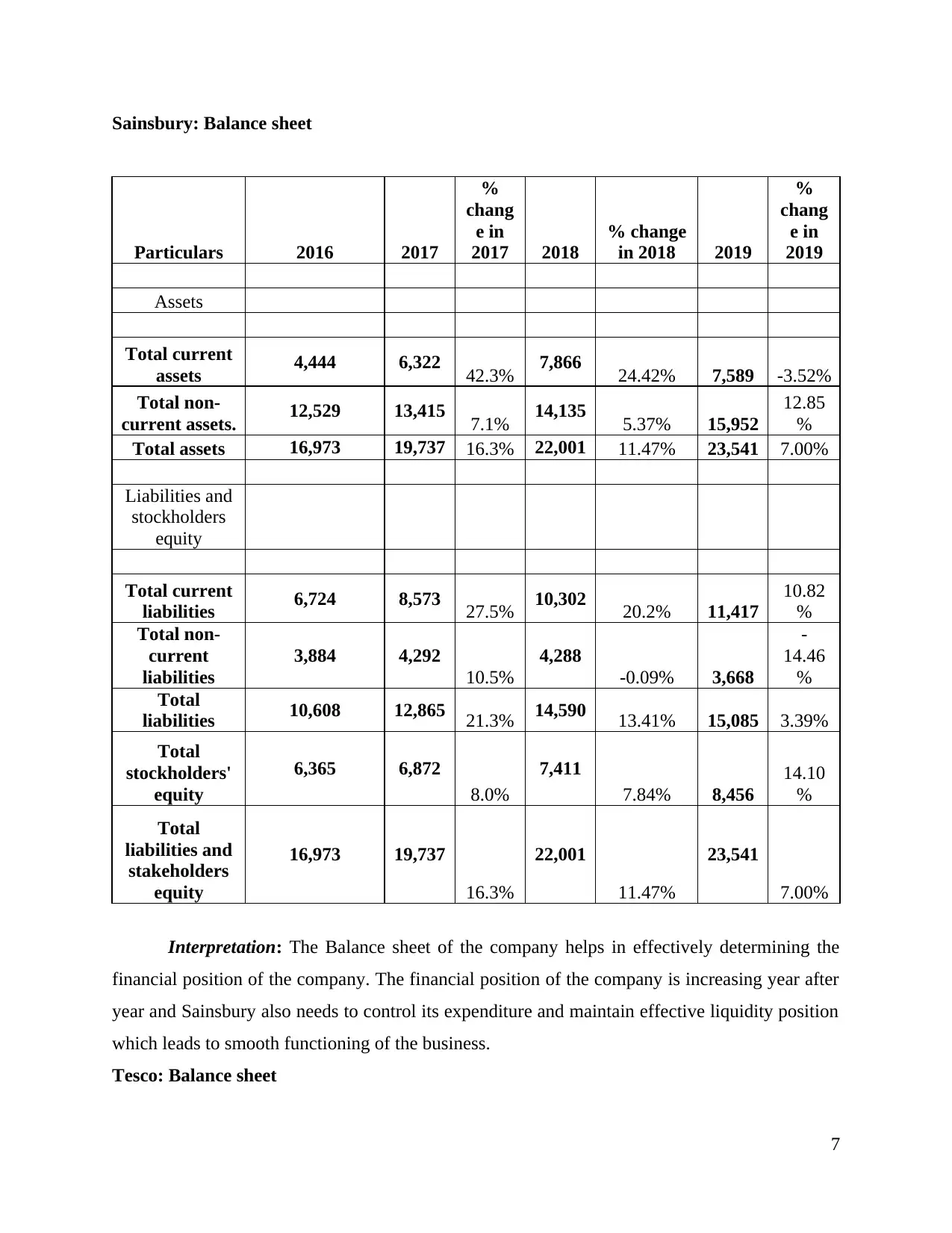
Particulars 2016 2017
%
chang
e in
2017 2018
% change
in 2018 2019
%
chang
e in
2019
Assets
Total current
assets 4,444 6,322 42.3% 7,866 24.42% 7,589 -3.52%
Total non-
current assets. 12,529 13,415 7.1% 14,135 5.37% 15,952
12.85
%
Total assets 16,973 19,737 16.3% 22,001 11.47% 23,541 7.00%
Liabilities and
stockholders
equity
Total current
liabilities 6,724 8,573 27.5% 10,302 20.2% 11,417
10.82
%
Total non-
current
liabilities
3,884 4,292
10.5%
4,288
-0.09% 3,668
-
14.46
%
Total
liabilities 10,608 12,865 21.3% 14,590 13.41% 15,085 3.39%
Total
stockholders'
equity
6,365 6,872
8.0%
7,411
7.84% 8,456
14.10
%
Total
liabilities and
stakeholders
equity
16,973 19,737
16.3%
22,001
11.47%
23,541
7.00%
Interpretation: The Balance sheet of the company helps in effectively determining the
financial position of the company. The financial position of the company is increasing year after
year and Sainsbury also needs to control its expenditure and maintain effective liquidity position
which leads to smooth functioning of the business.
Tesco: Balance sheet
7
⊘ This is a preview!⊘
Do you want full access?
Subscribe today to unlock all pages.

Trusted by 1+ million students worldwide

financial position of the Tesco plc. has severely reduced in the year 2018. This indicates that the
company has to manage its operations effectively.
Vertical Analysis
Vertical analysis of the company helps in determining the relative position of the
financial statements. It is very useful for the management as it helps in determining the various
change in the financial statements of the company.
Income statement Sainsbury
8
Paraphrase This Document
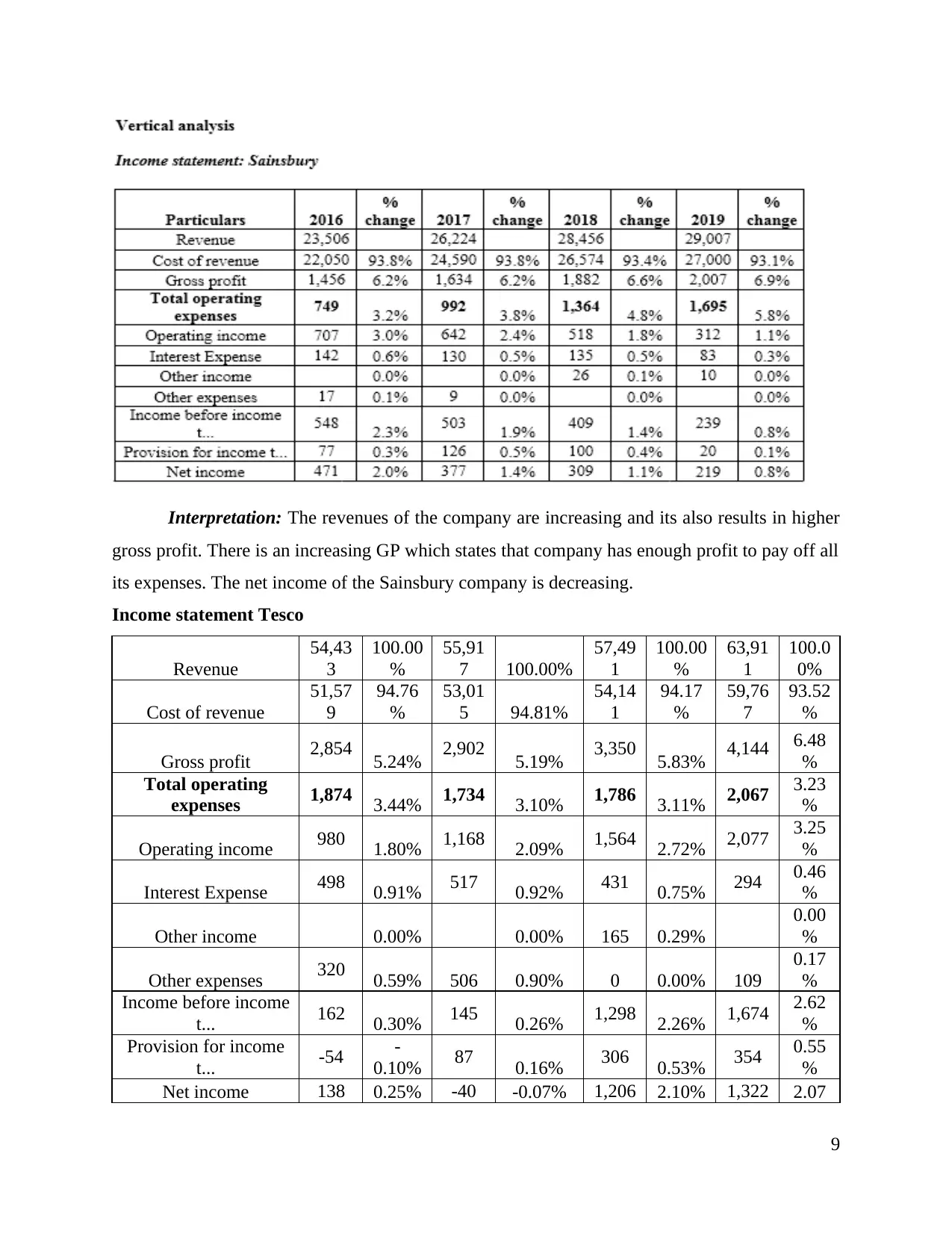
gross profit. There is an increasing GP which states that company has enough profit to pay off all
its expenses. The net income of the Sainsbury company is decreasing.
Income statement Tesco
Revenue
54,43
3
100.00
%
55,91
7 100.00%
57,49
1
100.00
%
63,91
1
100.0
0%
Cost of revenue
51,57
9
94.76
%
53,01
5 94.81%
54,14
1
94.17
%
59,76
7
93.52
%
Gross profit 2,854 5.24% 2,902 5.19% 3,350 5.83% 4,144 6.48
%
Total operating
expenses 1,874 3.44% 1,734 3.10% 1,786 3.11% 2,067 3.23
%
Operating income 980 1.80% 1,168 2.09% 1,564 2.72% 2,077 3.25
%
Interest Expense 498 0.91% 517 0.92% 431 0.75% 294 0.46
%
Other income 0.00% 0.00% 165 0.29%
0.00
%
Other expenses 320 0.59% 506 0.90% 0 0.00% 109
0.17
%
Income before income
t... 162 0.30% 145 0.26% 1,298 2.26% 1,674 2.62
%
Provision for income
t... -54 -
0.10% 87 0.16% 306 0.53% 354 0.55
%
Net income 138 0.25% -40 -0.07% 1,206 2.10% 1,322 2.07
9
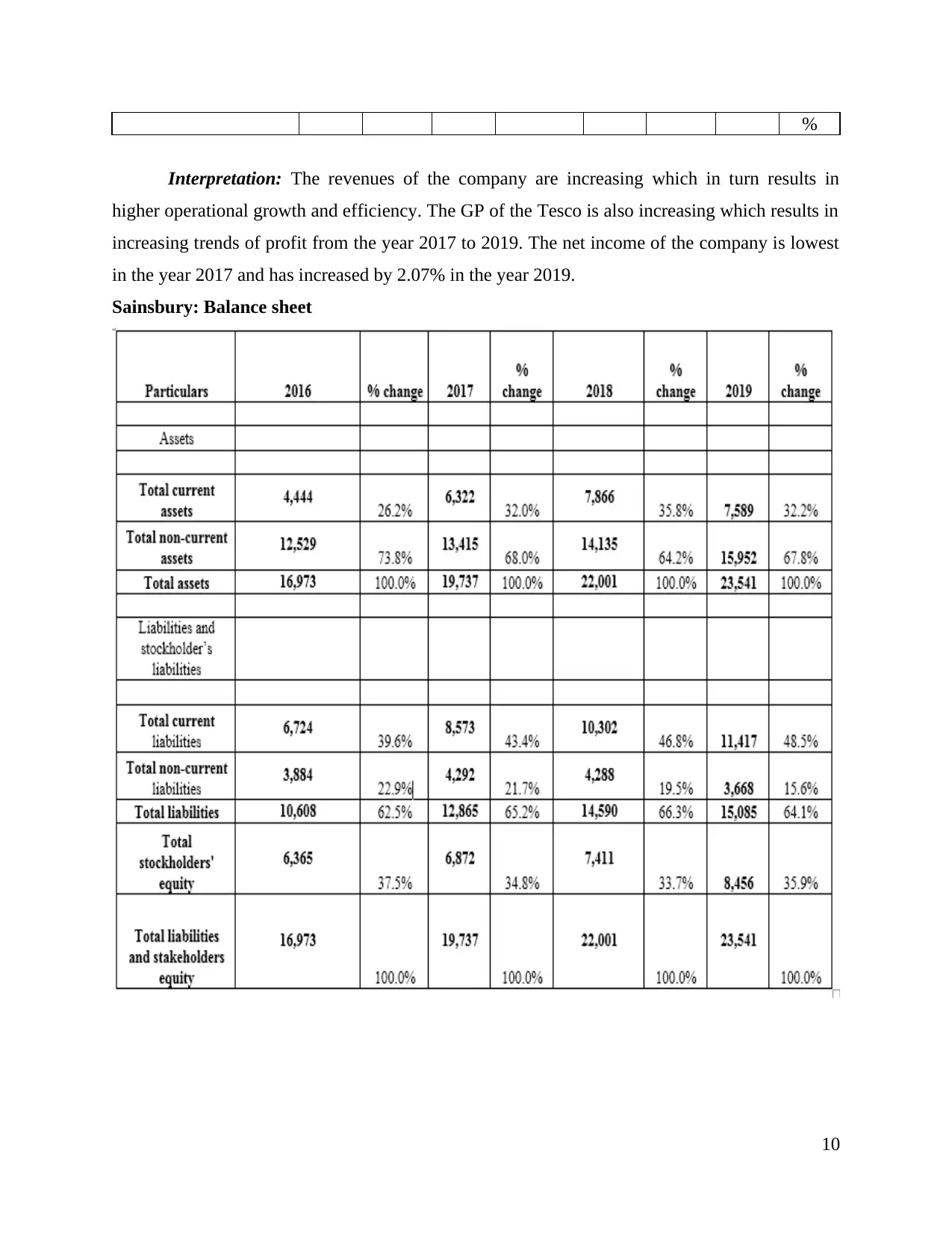
Interpretation: The revenues of the company are increasing which in turn results in
higher operational growth and efficiency. The GP of the Tesco is also increasing which results in
increasing trends of profit from the year 2017 to 2019. The net income of the company is lowest
in the year 2017 and has increased by 2.07% in the year 2019.
Sainsbury: Balance sheet
10
⊘ This is a preview!⊘
Do you want full access?
Subscribe today to unlock all pages.

Trusted by 1+ million students worldwide
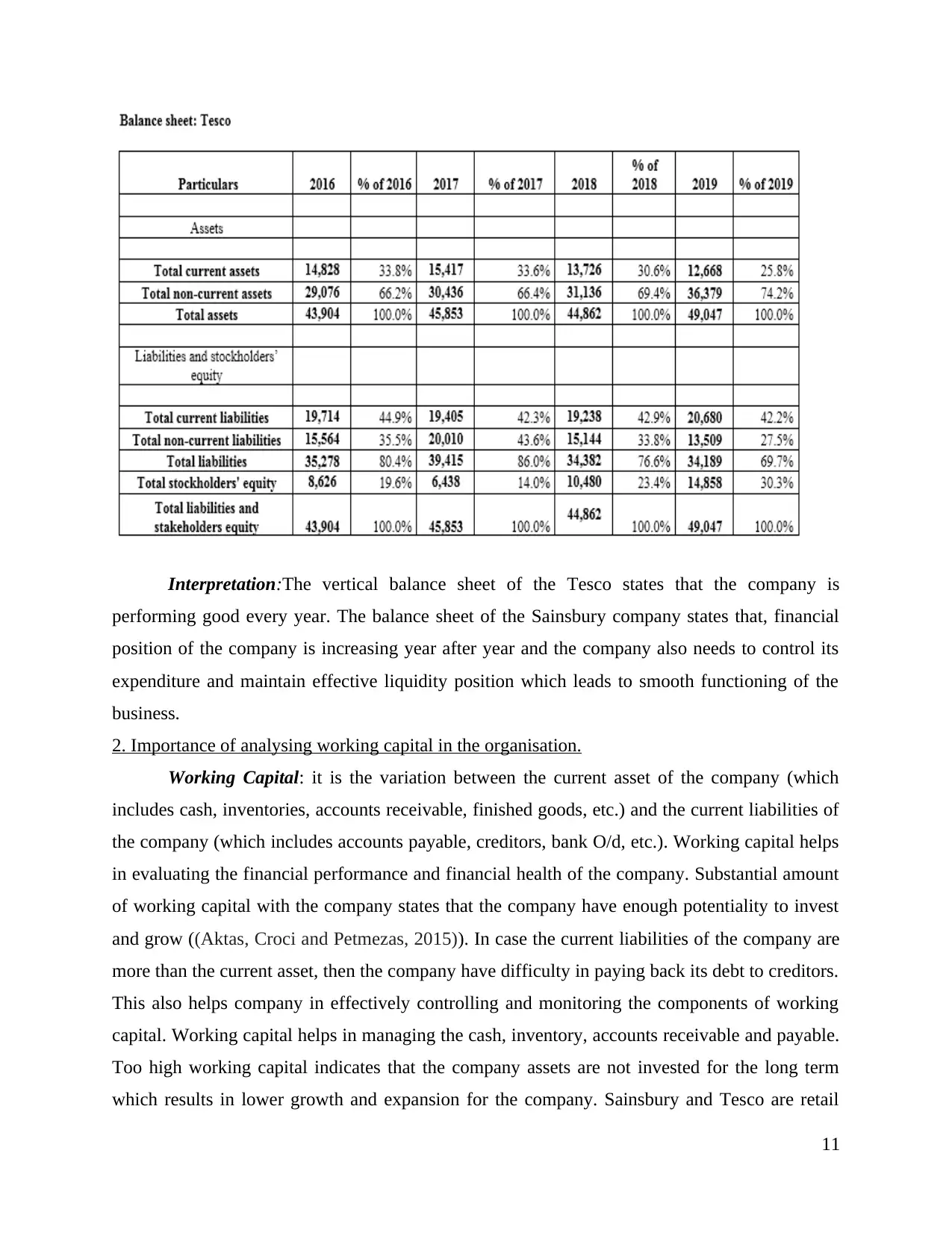
performing good every year. The balance sheet of the Sainsbury company states that, financial
position of the company is increasing year after year and the company also needs to control its
expenditure and maintain effective liquidity position which leads to smooth functioning of the
business.
2. Importance of analysing working capital in the organisation.
Working Capital: it is the variation between the current asset of the company (which
includes cash, inventories, accounts receivable, finished goods, etc.) and the current liabilities of
the company (which includes accounts payable, creditors, bank O/d, etc.). Working capital helps
in evaluating the financial performance and financial health of the company. Substantial amount
of working capital with the company states that the company have enough potentiality to invest
and grow ((Aktas, Croci and Petmezas, 2015)). In case the current liabilities of the company are
more than the current asset, then the company have difficulty in paying back its debt to creditors.
This also helps company in effectively controlling and monitoring the components of working
capital. Working capital helps in managing the cash, inventory, accounts receivable and payable.
Too high working capital indicates that the company assets are not invested for the long term
which results in lower growth and expansion for the company. Sainsbury and Tesco are retail
11
Paraphrase This Document
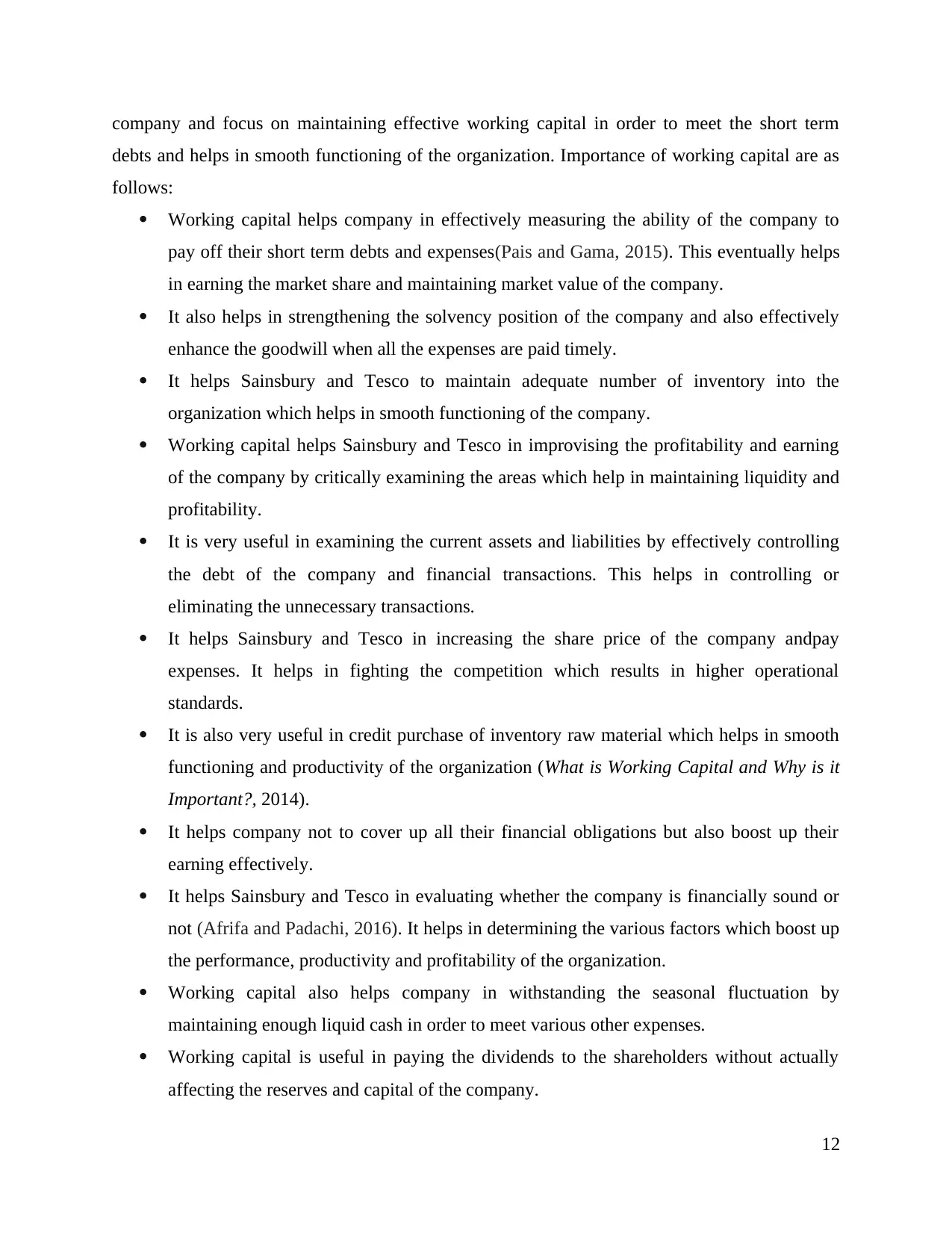
debts and helps in smooth functioning of the organization. Importance of working capital are as
follows:
Working capital helps company in effectively measuring the ability of the company to
pay off their short term debts and expenses(Pais and Gama, 2015). This eventually helps
in earning the market share and maintaining market value of the company.
It also helps in strengthening the solvency position of the company and also effectively
enhance the goodwill when all the expenses are paid timely.
It helps Sainsbury and Tesco to maintain adequate number of inventory into the
organization which helps in smooth functioning of the company.
Working capital helps Sainsbury and Tesco in improvising the profitability and earning
of the company by critically examining the areas which help in maintaining liquidity and
profitability.
It is very useful in examining the current assets and liabilities by effectively controlling
the debt of the company and financial transactions. This helps in controlling or
eliminating the unnecessary transactions.
It helps Sainsbury and Tesco in increasing the share price of the company andpay
expenses. It helps in fighting the competition which results in higher operational
standards.
It is also very useful in credit purchase of inventory raw material which helps in smooth
functioning and productivity of the organization (What is Working Capital and Why is it
Important?, 2014).
It helps company not to cover up all their financial obligations but also boost up their
earning effectively.
It helps Sainsbury and Tesco in evaluating whether the company is financially sound or
not (Afrifa and Padachi, 2016). It helps in determining the various factors which boost up
the performance, productivity and profitability of the organization.
Working capital also helps company in withstanding the seasonal fluctuation by
maintaining enough liquid cash in order to meet various other expenses.
Working capital is useful in paying the dividends to the shareholders without actually
affecting the reserves and capital of the company.
12
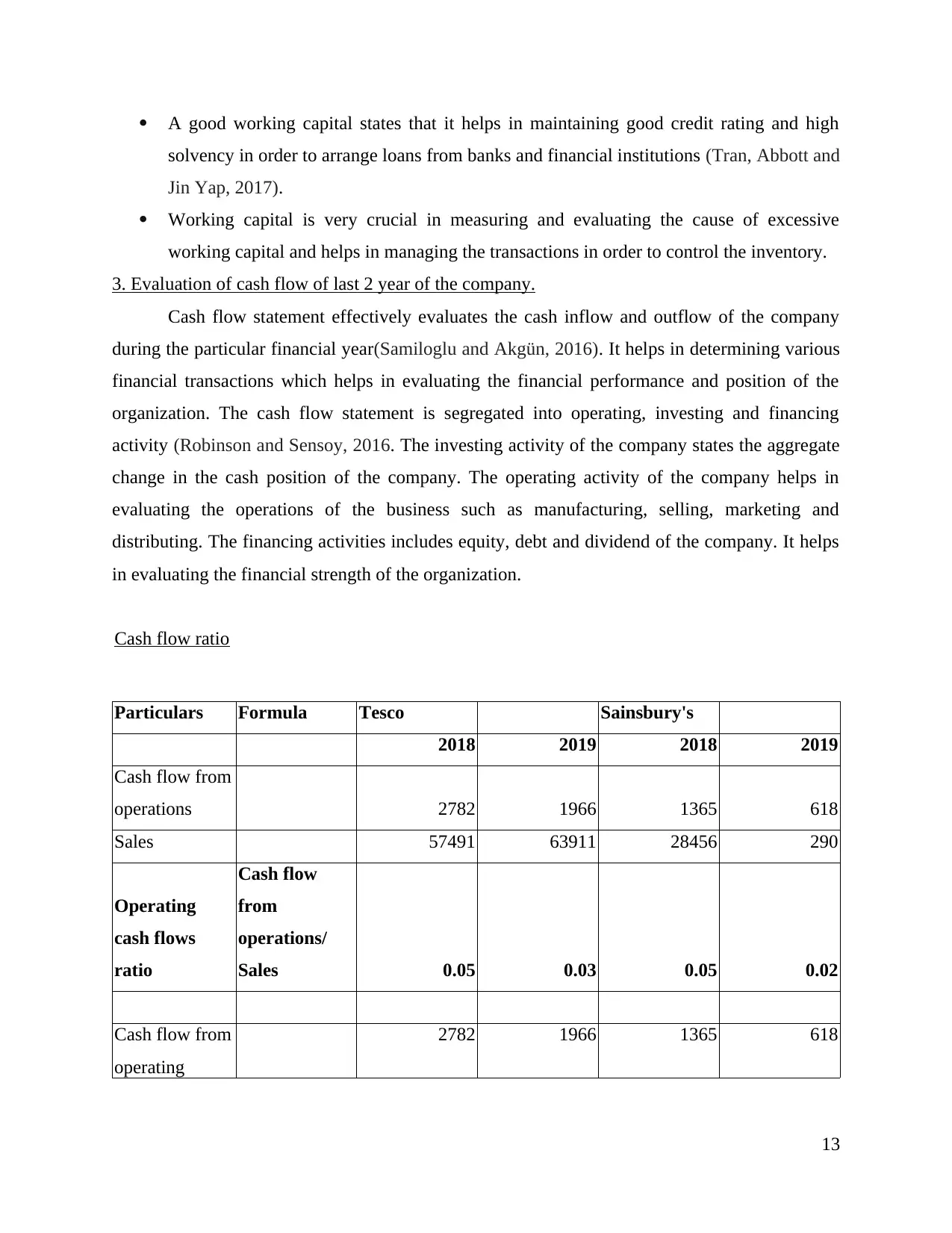
solvency in order to arrange loans from banks and financial institutions (Tran, Abbott and
Jin Yap, 2017).
Working capital is very crucial in measuring and evaluating the cause of excessive
working capital and helps in managing the transactions in order to control the inventory.
3. Evaluation of cash flow of last 2 year of the company.
Cash flow statement effectively evaluates the cash inflow and outflow of the company
during the particular financial year(Samiloglu and Akgün, 2016). It helps in determining various
financial transactions which helps in evaluating the financial performance and position of the
organization. The cash flow statement is segregated into operating, investing and financing
activity (Robinson and Sensoy, 2016. The investing activity of the company states the aggregate
change in the cash position of the company. The operating activity of the company helps in
evaluating the operations of the business such as manufacturing, selling, marketing and
distributing. The financing activities includes equity, debt and dividend of the company. It helps
in evaluating the financial strength of the organization.
Cash flow ratio
Particulars Formula Tesco Sainsbury's
2018 2019 2018 2019
Cash flow from
operations 2782 1966 1365 618
Sales 57491 63911 28456 290
Operating
cash flows
ratio
Cash flow
from
operations/
Sales 0.05 0.03 0.05 0.02
Cash flow from
operating
2782 1966 1365 618
13
⊘ This is a preview!⊘
Do you want full access?
Subscribe today to unlock all pages.

Trusted by 1+ million students worldwide
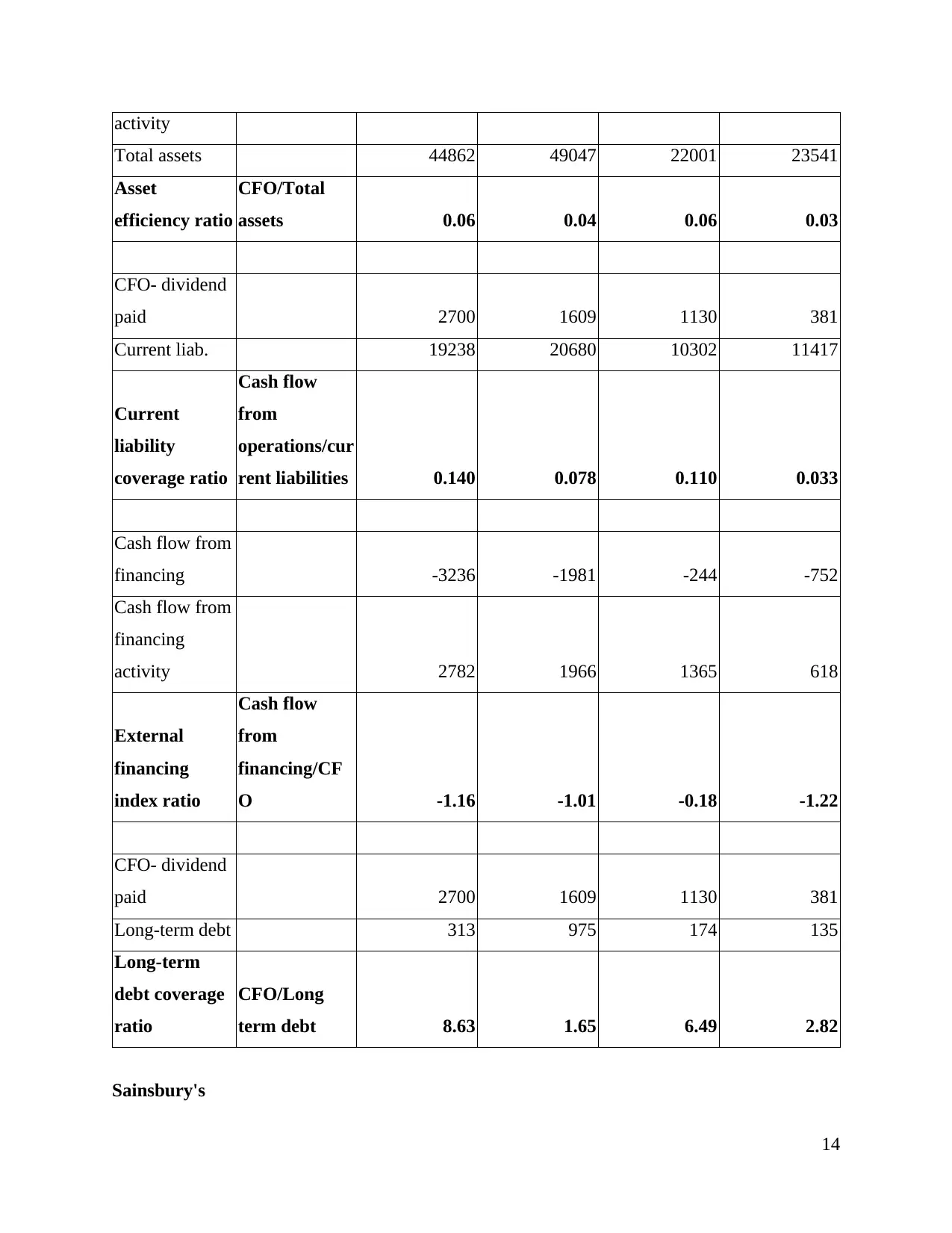
Total assets 44862 49047 22001 23541
Asset
efficiency ratio
CFO/Total
assets 0.06 0.04 0.06 0.03
CFO- dividend
paid 2700 1609 1130 381
Current liab. 19238 20680 10302 11417
Current
liability
coverage ratio
Cash flow
from
operations/cur
rent liabilities 0.140 0.078 0.110 0.033
Cash flow from
financing -3236 -1981 -244 -752
Cash flow from
financing
activity 2782 1966 1365 618
External
financing
index ratio
Cash flow
from
financing/CF
O -1.16 -1.01 -0.18 -1.22
CFO- dividend
paid 2700 1609 1130 381
Long-term debt 313 975 174 135
Long-term
debt coverage
ratio
CFO/Long
term debt 8.63 1.65 6.49 2.82
Sainsbury's
14
Paraphrase This Document
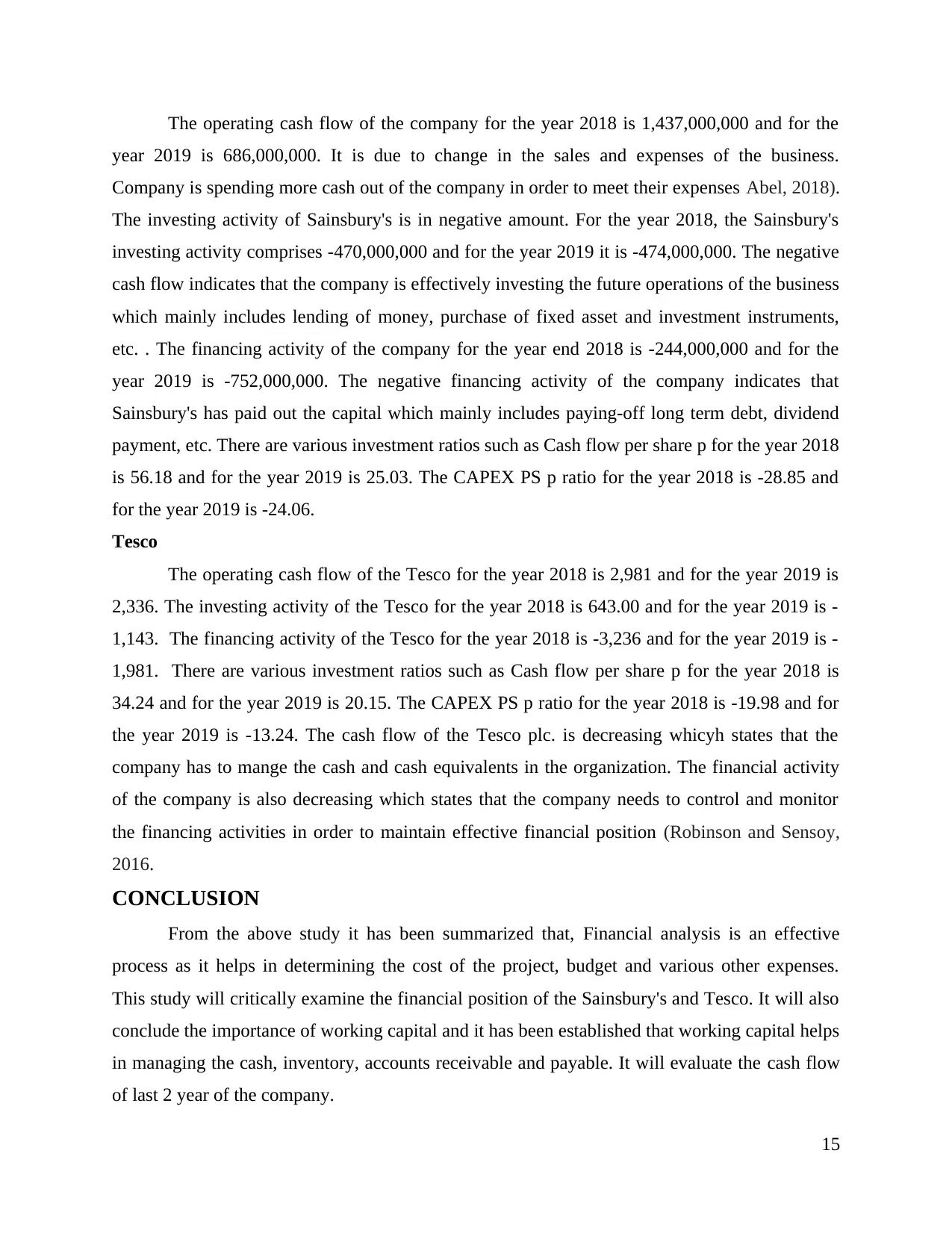
year 2019 is 686,000,000. It is due to change in the sales and expenses of the business.
Company is spending more cash out of the company in order to meet their expenses Abel, 2018).
The investing activity of Sainsbury's is in negative amount. For the year 2018, the Sainsbury's
investing activity comprises -470,000,000 and for the year 2019 it is -474,000,000. The negative
cash flow indicates that the company is effectively investing the future operations of the business
which mainly includes lending of money, purchase of fixed asset and investment instruments,
etc. . The financing activity of the company for the year end 2018 is -244,000,000 and for the
year 2019 is -752,000,000. The negative financing activity of the company indicates that
Sainsbury's has paid out the capital which mainly includes paying-off long term debt, dividend
payment, etc. There are various investment ratios such as Cash flow per share p for the year 2018
is 56.18 and for the year 2019 is 25.03. The CAPEX PS p ratio for the year 2018 is -28.85 and
for the year 2019 is -24.06.
Tesco
The operating cash flow of the Tesco for the year 2018 is 2,981 and for the year 2019 is
2,336. The investing activity of the Tesco for the year 2018 is 643.00 and for the year 2019 is -
1,143. The financing activity of the Tesco for the year 2018 is -3,236 and for the year 2019 is -
1,981. There are various investment ratios such as Cash flow per share p for the year 2018 is
34.24 and for the year 2019 is 20.15. The CAPEX PS p ratio for the year 2018 is -19.98 and for
the year 2019 is -13.24. The cash flow of the Tesco plc. is decreasing whicyh states that the
company has to mange the cash and cash equivalents in the organization. The financial activity
of the company is also decreasing which states that the company needs to control and monitor
the financing activities in order to maintain effective financial position (Robinson and Sensoy,
2016.
CONCLUSION
From the above study it has been summarized that, Financial analysis is an effective
process as it helps in determining the cost of the project, budget and various other expenses.
This study will critically examine the financial position of the Sainsbury's and Tesco. It will also
conclude the importance of working capital and it has been established that working capital helps
in managing the cash, inventory, accounts receivable and payable. It will evaluate the cash flow
of last 2 year of the company.
15
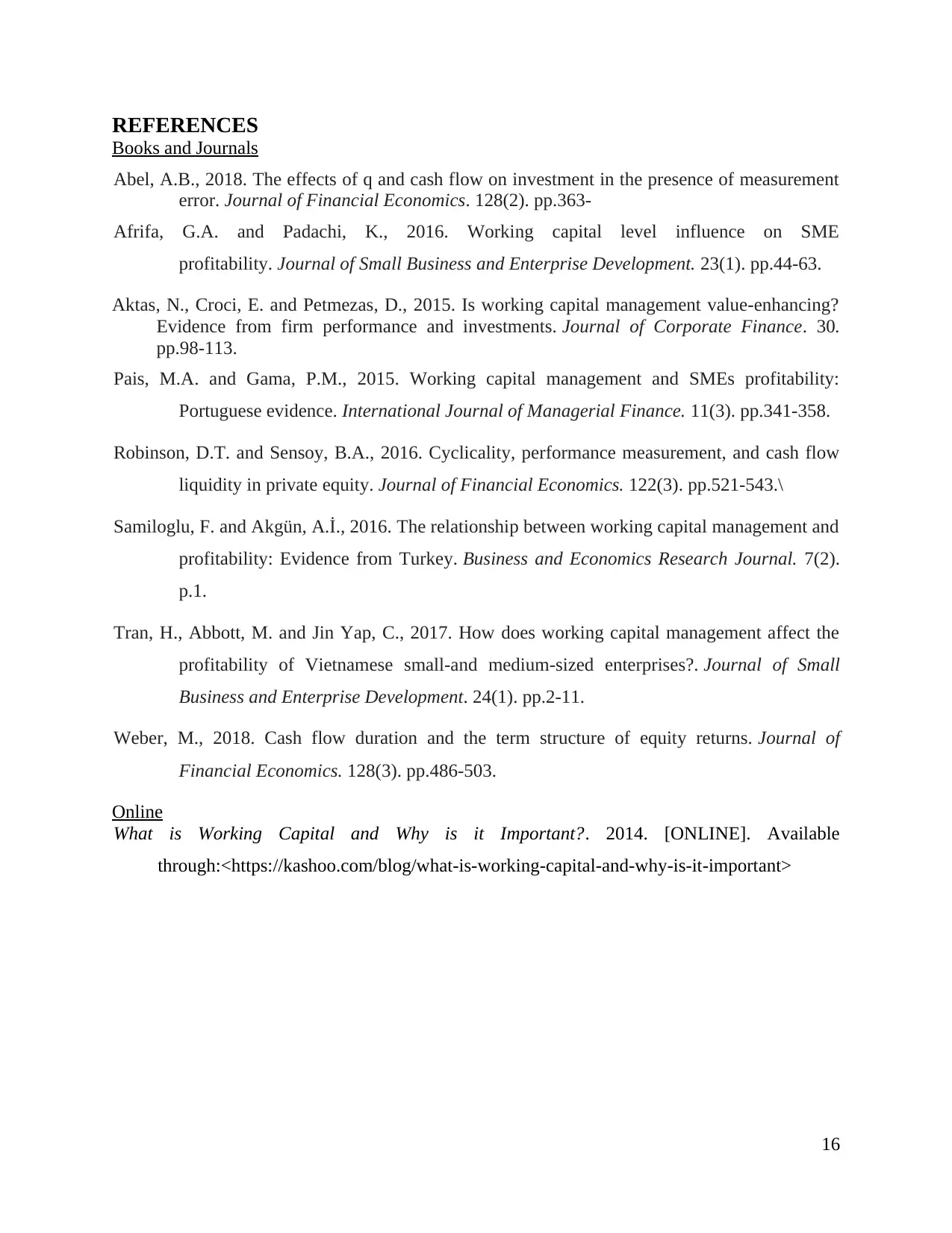
Books and Journals
Abel, A.B., 2018. The effects of q and cash flow on investment in the presence of measurement
error. Journal of Financial Economics. 128(2). pp.363-
Afrifa, G.A. and Padachi, K., 2016. Working capital level influence on SME
profitability. Journal of Small Business and Enterprise Development. 23(1). pp.44-63.
Aktas, N., Croci, E. and Petmezas, D., 2015. Is working capital management value-enhancing?
Evidence from firm performance and investments. Journal of Corporate Finance. 30.
pp.98-113.
Pais, M.A. and Gama, P.M., 2015. Working capital management and SMEs profitability:
Portuguese evidence. International Journal of Managerial Finance. 11(3). pp.341-358.
Robinson, D.T. and Sensoy, B.A., 2016. Cyclicality, performance measurement, and cash flow
liquidity in private equity. Journal of Financial Economics. 122(3). pp.521-543.\
Samiloglu, F. and Akgün, A.İ., 2016. The relationship between working capital management and
profitability: Evidence from Turkey. Business and Economics Research Journal. 7(2).
p.1.
Tran, H., Abbott, M. and Jin Yap, C., 2017. How does working capital management affect the
profitability of Vietnamese small-and medium-sized enterprises?. Journal of Small
Business and Enterprise Development. 24(1). pp.2-11.
Weber, M., 2018. Cash flow duration and the term structure of equity returns. Journal of
Financial Economics. 128(3). pp.486-503.
Online
What is Working Capital and Why is it Important?. 2014. [ONLINE]. Available
through:<https://kashoo.com/blog/what-is-working-capital-and-why-is-it-important>
16
⊘ This is a preview!⊘
Do you want full access?
Subscribe today to unlock all pages.

Trusted by 1+ million students worldwide
Related Documents
Your All-in-One AI-Powered Toolkit for Academic Success.
+13062052269
info@desklib.com
Available 24*7 on WhatsApp / Email
![[object Object]](/_next/static/media/star-bottom.7253800d.svg)
© 2024 | Zucol Services PVT LTD | All rights reserved.





